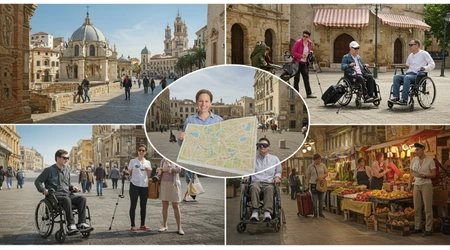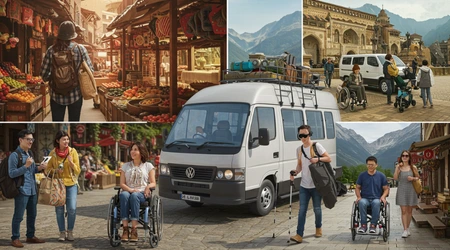Travel Tips for People with Physical Disabilities

Travel tips for people with physical disabilities unlock a world of exploration, adventure, and connection, tailored to unique mobility needs.
In 2025, accessible travel thrives as destinations, airlines, and tour operators embrace inclusivity, breaking barriers for travelers with physical disabilities.
Planning a trip, however, demands foresight, creativity, and reliable resources to ensure safety and comfort. Imagine a journey as seamless as a well-choreographed dance every step intentional, every move accessible.
This guide offers practical, up-to-date travel tips for people with physical disabilities, blending real-world insights with actionable strategies to make your adventures unforgettable.
Travel isn’t just about reaching a destination; it’s about embracing experiences that spark joy and broaden perspectives.
For individuals with physical disabilities, the journey requires extra preparation, but the rewards are immense.
According to a 2023 Open Doors Organization study, 27 million Americans with disabilities traveled in the past year, spending $58.2 billion.
This underscores the growing demand for accessible travel options. Whether you’re dreaming of cobblestone streets in Europe or serene beaches in the Caribbean, these travel tips for people with physical disabilities empower you to explore confidently.
This article dives deep into planning, transportation, accommodations, and destination exploration, offering fresh perspectives and real-world examples.
From leveraging cutting-edge apps to navigating airports with ease, we’ll cover it all. Ready to turn your travel dreams into reality? Let’s embark on this journey together.
Planning Your Accessible Adventure
Meticulous planning transforms travel dreams into reality for those with physical disabilities. Start by researching destinations with strong accessibility infrastructure.
Cities like Barcelona and Seattle boast wheelchair-friendly public transport and attractions. Use resources like AccessNow to check accessibility ratings for venues. Detailed planning ensures surprises are delightful, not daunting.
Consider your specific mobility needs when selecting destinations. For example, Sarah, a wheelchair user from Chicago, planned a trip to London.
She used Wheelchair Travel’s city guide to confirm accessible Tube stations. Her preparation paid off with seamless museum visits. Always verify accessibility details directly with venues to avoid outdated information.
Another key step is consulting specialized travel agencies. Spin the Globe, founded by Sylvia Longmire, offers tailored itineraries for wheelchair users.
These agencies connect travelers with accessible tours, ensuring peace of mind. Early planning also allows time to arrange medical equipment rentals or travel insurance. Why settle for less when you can travel confidently?
Engage with online communities for real-world insights. Forums like Curb Free with Cory Lee’s blog offer tips from experienced disabled travelers.
++ How to Create a Sensory-Friendly Living Room
These platforms reveal hidden gems, like accessible hiking trails in Colorado. Joining these discussions sparks inspiration and builds confidence for your journey.
Lastly, create a detailed itinerary with buffer time. Fatigue or unexpected delays can arise, so plan rest periods.
Sarah’s London trip included afternoon breaks, allowing her to enjoy evening outings. A flexible schedule balances exploration with comfort, making your trip truly memorable.

Navigating Transportation with Ease
Air travel can feel like navigating a labyrinth, but preparation simplifies the process. Contact airlines at booking to request assistance, like wheelchair transfers or priority boarding.
Delta and Lufthansa, in 2025, offer enhanced accessible seating options. Early communication ensures a smoother journey.
For example, John, a paraplegic traveler, flew to Tokyo using Japan Airlines’ accessible services. He requested a bulkhead seat and confirmed aisle chair availability.
His proactive approach minimized stress during transfers. Always double-check airline policies on mobility devices to avoid surprises.
Also read: Setting Up an Accessible Home Office: Step-by-Step
Ground transportation requires equal attention. Research accessible public transit options, like London’s wheelchair-friendly buses or New York’s Access-A-Ride.
Apps like Aira, which provides real-time navigation assistance, are game-changers. John used Aira to navigate Tokyo’s busy train stations, feeling empowered and independent.
Ride-sharing services like UberWAV offer wheelchair-accessible vehicles in major cities. Book these in advance to ensure availability.
For road trips, companies like Blvd.com provide advice on renting accessible vans. These options offer flexibility, letting you explore at your own pace.
Read more: How Caregivers Can Support Independent Living at Home
Don’t overlook travel insurance tailored for disabilities. Seven Corners offers plans covering mobility device loss or medical emergencies.
This safety net lets you focus on the journey, not the what-ifs. With these travel tips for people with physical disabilities, transportation becomes a bridge, not a barrier.
Choosing Accessible Accommodations
Finding the right lodging is like finding the perfect key to unlock your travel experience. Prioritize hotels with verified accessibility features, like roll-in showers or braille signage.
Chains like Hilton and Marriott lead in 2025 with ADA-compliant rooms. Always call to confirm specific needs are met.
Consider alternative accommodations, such as Airbnb’s accessibility filters. Emma, a UK traveler with muscular dystrophy, booked an accessible cottage in Cornwall.
She verified step-free access and wide doorways via photos and host communication. This ensured her stay was comfortable and stress-free.
Read reviews from disabled travelers on platforms like TripAdvisor. These insights reveal real-world experiences, like whether elevators are reliable.
Emma found a review highlighting a hotel’s spacious bathrooms, swaying her decision. Authentic feedback builds trust in your choices.
Check proximity to key attractions to minimize travel fatigue. A centrally located hotel in Paris allowed Sarah to visit the Louvre without exhausting transfers.
Accessibility maps, like those from Wheelmap, help identify nearby accessible routes. Location matters as much as amenities.
Finally, confirm emergency accessibility. Ask about evacuation plans for wheelchair users or those with mobility challenges.
Hotels with trained staff, like those certified by AccessAble, prioritize safety. These travel tips for people with physical disabilities ensure your stay is both comfortable and secure.
Exploring Destinations with Confidence

Discovering new places is the heart of travel, and accessibility shouldn’t dim that spark. Research attractions with detailed accessibility guides, like those for the Colosseum in Rome.
Many sites now offer tactile tours or audio descriptions. Start with official tourism websites for accurate information.
Adaptive activities are booming in 2025. For instance, Hawaii’s surf clinics offer wheelchair-accessible boards, letting travelers like John ride waves.
National parks in the U.S. provide all-terrain wheelchairs for trails. These options make adventure inclusive and exhilarating.
Local guides with disability expertise enhance experiences. In Munich, tour companies offer accessible Champions League final packages, including wheelchair-friendly stadium access.
Booking such tours ensures you miss nothing while staying comfortable. Why let barriers steal the spotlight?
Engage with local disability organizations for insider tips. They often know hidden accessible gems, like quiet cafes with ramps.
In Tokyo, John discovered an accessible garden through a local group. These connections enrich your journey with authentic experiences.
Keep a portable accessibility toolkit. Items like a lightweight ramp or suction grips ease unexpected obstacles.
Emma used a portable ramp in Cornwall to access a historic site. These travel tips for people with physical disabilities make exploration vibrant and barrier-free.
Table: Key Resources for Accessible Travel
| Resource | Description | Website |
|---|---|---|
| AccessNow | Crowdsourced accessibility ratings | accessnow.com |
| Wheelchair Travel | Detailed city guides for wheelchair users | wheelchairtravel.org |
| Aira | Real-time navigation via smartphone | aira.io |
| Spin the Globe | Accessible travel agency and blog | spintheglobe.net |
| Seven Corners | Travel insurance for disability needs | sevencorners.com |
Leveraging Technology for Seamless Travel
Technology is a traveler’s best friend, especially for those with physical disabilities. Apps like AccessNow crowdsource real-time accessibility data for restaurants and attractions.
In 2025, these tools are more robust, offering detailed venue ratings. Download them before your trip.
Navigation apps like Aira or Google Maps’ accessible routes feature guide you through unfamiliar terrain.
Sarah used Google Maps to find step-free paths in London, avoiding stressful detours. These tools empower independent exploration, turning challenges into opportunities.
Wearable devices, like smartwatches with health alerts, enhance safety. They monitor vitals or send emergency signals, offering peace of mind.
John’s smartwatch alerted his family during a minor health scare abroad. Technology bridges gaps, making travel safer.
Online communities, like Reddit’s r/disabilitytravel, provide peer advice. Travelers share hacks, like using pool noodles for wheelchair cushioning.
These forums foster connection and creativity, enriching your planning. Engage actively to uncover unique solutions.
Finally, use AI-powered translation apps for non-English destinations. Apps like iTranslate ensure clear communication with locals about accessibility needs.
These travel tips for people with physical disabilities harness technology to make your journey seamless and empowering.
Frequently Asked Questions
Q: How can I ensure a hotel is truly accessible?
A: Call the hotel directly to confirm features like roll-in showers and verify reviews on platforms like TripAdvisor for real traveler experiences.
Q: What’s the best way to navigate airports with a disability?
A: Contact your airline at booking for assistance, use apps like Aira for navigation, and request priority boarding to ease transfers.
Q: Are there affordable accessible travel options?
A: Yes, budget-friendly options exist. Use Airbnb’s accessibility filters, research free attractions, and book with agencies like Spin the Globe for deals.
Q: How do I find adaptive activities at my destination?
A: Check tourism websites, contact local disability organizations, and explore tour companies offering adaptive sports like wheelchair-accessible hiking or surfing.
